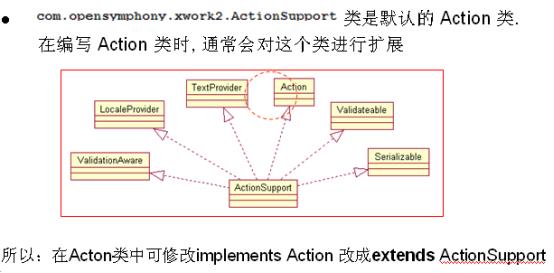Struts2 第四讲 -- Struts2的基本配置
Posted Abri
tags:
篇首语:本文由小常识网(cha138.com)小编为大家整理,主要介绍了Struts2 第四讲 -- Struts2的基本配置相关的知识,希望对你有一定的参考价值。
5.struts2的基本配置
5.1 struts2的访问连接url
在struts1中,通过<action path=“/primer/helloWorldAction.action”>节点的path属性指定访问该action的URL路径。
在struts2中,访问struts2中action的URL路径由两部份组成:包的命名空间+action的名称
例如: 访问本例子HelloWorldAction的URL路径为: /primer/helloWorldAction.action
(注意:完整路径为:http://localhost:端口//内容路径primer/helloWorldAction.action)。另外我们也可以加上.action后缀访问此Action,对于struts2来说,默认是.action结尾,或者是什么都不加。

<package name="primer" namespace="/primer" extends="struts-default"> <default-action-ref name="helloWorldAction"></default-action-ref> <action name="helloWorldAction" class="cn.youric.you.one_primer.HelloWorldAction"> <result name="success">/primer/success.jsp</result> <result name="add">/primer/add.jsp</result> </action> </package>
5.2 struts2的namespace
- 1).获得请求路径的URI,例如url是: http://server/struts2/path1/path2/path3/test.action
- 2).首先寻找namespace为/path1/path2/path3的package,如果存在这个package,则在这个package中寻找名字为test的action,如果不存在这个package则转步骤3;
- 3).寻找namespace为/path1/path2的package,如果存在这个package,则在这个package中寻找名字为test的action,如果不存在这个package,则转步骤4;
- 4).寻找namespace为/path1的package, 如果存在这个package,则在这个package中寻找名字为test的action,
- 5).如果仍然不存在这个package,就去默认的namaspace的package下面去找名字为test的action(默认的命名空间为空字符串“/” ),
- 如果还是找不到,页面提示找不到action。
<body> 入门的路径:<br> 测试Struts2带有参数:<a href="${pageContext.request.contextPath}/primer/helloWorldAction.action?username=\'zhangsanfeng\'">helloWorld</a><br> 测试命名空间:<a href="${pageContext.request.contextPath}/primer/primer/helloWorldAction.action">helloWorld</a><br> 测试action:<a href="${pageContext.request.contextPath}/primer/helloWorldAction">helloWorld</a><br> </body>
上面是我们写的test.jsp页面,我们发现在第一个链接和第二个连接中,namespace的名称是不同的,但是仍然都能访问到同一个action,这就是namespace的路径寻找,以第二个链接为例,首先在/primer/primer下寻找helloWorldAction.action,如果不存在,那么就在/primer下查找,发现存在.
5.3 Action配置中的各项默认值
问题:如果没有为action指定class,默认是com.opensymphony.xwork2.ActionSupport,执行ActionSupport中的execute方法
public String execute() throws Exception { return SUCCESS; }
由struts-default.xml文件中的以下代码
<default-class-ref class="com.opensymphony.xwork2.ActionSupport" />决定,class是可以由我们决定的,这样就可以在项目中把所有的问题访问转移到一个处理错误的页面上。
以下代码:
<package name="primer" namespace="/primer" extends="struts-default"> <default-action-ref name="helloWorldAction"></default-action-ref> <action name="helloWorldAction" class="cn.youric.you.one_primer.HelloWorldAction"> <result name="success">/primer/success.jsp</result> <result name="add">/primer/add.jsp</result> </action> </package>
- 1>如果没有为action指定class,默认是ActionSupport。
- 2>如果没有为action指定method,默认执行action中的execute() 方法。ActionSupport的execute方法里面就一句话return "success";如果为action指定method,就会按照method指定的方法,去执行Action类中的同名方法
- 3>如果没有指定result的name属性,默认值为success。
- 4>问题:如果请求的路径查找不到action的情况下,程序运行会抛出异常 ,可以通过配置当找不到action的情况下,会执行默认的action【参见Struts2中的struts。Xml配置和解释】
5.4 ActionSupport类详解

5.5 struts2的请求后缀
StrutsPrepareAndExecuteFilter是Struts 2框架的核心控制器,它负责拦截由<url-pattern>/*</url-pattern>指定的所有用户请求,当用户请求到达时,该Filter会过滤用户的请求。默认情况下,如果用户请求的路径不带后缀或者后缀以.action结尾,这时请求将被转入Struts 2框架处理,否则Struts 2框架将略过该请求的处理。
这是因为根据配置文件:struts2-core-2.3.3.jar包下的org.apache.struts2/default.properties文件定义的常量决定,
struts.action.extension=action,
默认处理的后缀是可以通过常量”struts.action.extension“进行修改的,如下面配置Struts 2只处理以.do为后缀的请求路径,可以在struts.xml中配置:
<struts> <constant name="struts.action.extension" value="do"/> </struts>
这个配置会覆盖default.properties文件的配置。
如果用户需要指定多个请求后缀,则多个后缀之间以英文逗号(,)隔开。如:
<constant name="struts.action.extension" value="do,go"/>
这里注意:
多学一招:常量可以在struts.xml或struts.properties中配置,但是我们建议在struts.xml中配置,两种配置方式如下:
在struts.xml文件中配置常量
<struts> <constant name="struts.action.extension" value="do"/> </struts>
在struts.properties中配置常量, (struts.properties文件放置在src下)
struts.action.extension=do
因为常量可以在多个配置文件中进行定义,所以我们需要了解下struts2加载常量的搜索顺序:
- 1 struts-default.xml
- 2 struts-plugin.xml
- 3 struts.xml
- 4 struts.properties
- 5 web.xml
如果在多个文件中配置了同一个常量,则后一个文件中配置的常量值会覆盖前面文件中配置的常量值.
5.6 struts2常用的常量介绍
指定默认编码集,作用于HttpServletRequest的setCharacterEncoding方法 和freemarker 、velocity的输出
<constant name="struts.i18n.encoding" value="UTF-8"/>
该属性指定需要Struts 2处理的请求后缀,该属性的默认值是action,即所有匹配*.action的请求都由Struts2处理。如果用户需要指定多个请求后缀,则多个后缀之间以英文逗号(,)隔开
<constant name="struts.action.extension" value="do"/>
设置浏览器是否缓存静态内容,默认值为true(生产环境下使用),开发阶段最好关闭
<constant name="struts.serve.static.browserCache" value="false"/>
当struts的配置文件修改后,系统是否自动重新加载该文件,默认值为false(生产环境下使用),开发阶段最好打开
<constant name="struts.configuration.xml.reload" value="true"/>
开发模式下使用,这样可以打印出更详细的错误信息 ,同时可以自动加载struts2的配置文件和资源文件
<constant name="struts.devMode" value="true" />
默认的视图主题,设置为simple表示简单主题,目的是去掉struts2提供的css样式,因为在开发中,css样式事由美工设计的
<constant name="struts.ui.theme" value="simple" />
与spring集成时,指定由spring负责action对象的创建,这里在spring整合struts2的时候会用到,大家可以先记住
<constant name="struts.objectFactory" value="spring" />
该属性设置Struts 2是否支持动态方法调用,该属性的默认值是true。如果需要关闭动态方法调用,则可设置该属性为 false
<constant name="struts.enable.DynamicMethodInvocation" value="false"/>
上传文件的大小限制
<constant name="struts.multipart.maxSize" value=“10701096"/>
5.7 struts.xml可以指定多个xml文件
它的目的就是为了减轻struts.xml的数据加载负担,因为在大部分应用里,随着应用规模的增加,系统中Action的数量也会大量增加,导致struts.xml配置文件变得非常臃肿。为了避免struts.xml文件过于庞大、臃肿,提高struts.xml文件的可读性,我们可以将一个struts.xml配置文件分解成多个配置文件,然后在struts.xml文件中包含其他配置文件。下面的struts.xml通过<include>元素指定多个配置文件:
<struts> <include file="cn/youric/you/one_primer/struts-primer.xml"></include> <include file="cn/youric/you/two_context/struts-context.xml"></include> <include file="cn/youric/you/c_resulttype/struts-resulttype.xml"></include> <include file="cn/youric/you/d_pattern/struts-pattern.xml"></include> </struts>
通过这种方式,我们就可以将Struts 2的Action按模块添加在多个配置文件中。
以上是关于Struts2 第四讲 -- Struts2的基本配置的主要内容,如果未能解决你的问题,请参考以下文章